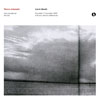Thomas Ankersmit, "Live in Utrecht"
 Although this is the first official release from this saxophonist and electronic artist, he has an illustrious list of collaborators, including the likes of Phill Niblock, Tony Conrad, and Borbetomagus. For this reason alone, the bar is set rather high for this album, and luckily Ankersmit lives up to the expectations.
Although this is the first official release from this saxophonist and electronic artist, he has an illustrious list of collaborators, including the likes of Phill Niblock, Tony Conrad, and Borbetomagus. For this reason alone, the bar is set rather high for this album, and luckily Ankersmit lives up to the expectations.
Recorded live, this 38 minute piece mixes live with pre-recorded elements, pairing Ankersmit’s saxophone playing with taped versions of himself, analog synthesizer, and some digital treatments as well.The recurring motif becomes the sound of his horn, sometimes in its pure, traditional format, such as towards the beginning of the performance where it is in tightly clipped bursts.Other times it is dissected and rebuilt into a different beast entirely, such as at the ending moments of the performance where pieces are looped and closely multi-tracked together to the point it resembles a mini-orchestra of sax players.The close, but slightly different pitches create unnatural harmonics as layers are snipped away, leaving only one singular loop at the end.
Between these natural reference points, there is a slew of digital and analog treated sounds that are placed together to create an idiosyncratic electro-acoustic sound that stands on its own.The snipped and looped horns at the beginning are eventually digitally deconstructed, leaving processed sound fragments that are far from identifiable to become the focus, with the most subtle of underlying melody to be perceived.
For a single live performance, it is a varied one, with a great deal of diversity in dynamics and structure.Clanging, raw high speed sounds and feedback-like swells clash to create an abrasive, gratingly harsh noises that will just as quickly retreat, leaving only a bass drone and high frequency textures.Some segments resemble a CD being decoded in the wrong order, with blobs of sound coming out seemingly at random.Mixing the high and low pitched elements does occur more than once, at one point there’s subwoofer rattling bass frequencies with ultrasonic, tweeter shredding treated horn noises that pulls a page from the early noise scene.Other moments sit more nicely in the middle, more comfortable frequency range, with what sounds like a duet between a broken AM radio and a laptop-based didgeridoo forming one of the closing segments of the performance.
While he uses familiar building blocks, the results on this album sound like no other artist, and considering his connections with Niblock and Conrad, Ankersmit takes a more maximalist approach to sound than would be expected.It isn’t an easy listen, with its frequently abrasive frequencies and erratic, jumpy structure.However, there are so many nuances and subtlety contained within that the more difficult moments are worth enduring, even for those who aren’t as fond of raw and harsh sounds as I.
samples:
 




